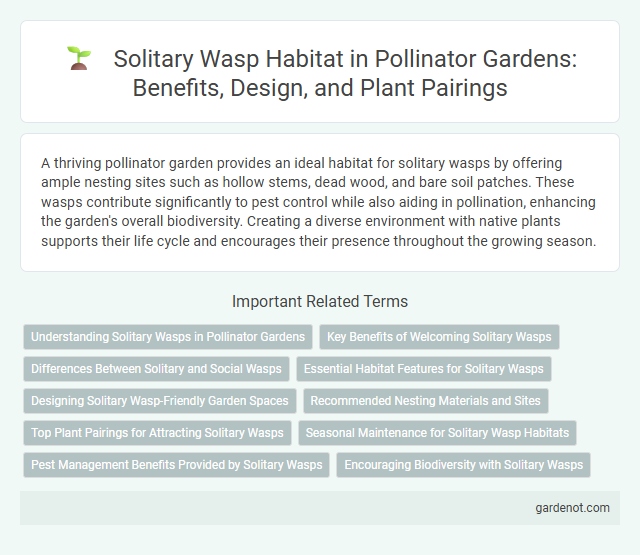A thriving pollinator garden provides an ideal habitat for solitary wasps by offering ample nesting sites such as hollow stems, dead wood, and bare soil patches. These wasps contribute significantly to pest control while also aiding in pollination, enhancing the garden's overall biodiversity. Creating a diverse environment with native plants supports their life cycle and encourages their presence throughout the growing season.
Understanding Solitary Wasps in Pollinator Gardens
Solitary wasps are vital pollinators that do not form colonies but instead nest individually in soil, wood, or hollow stems, enhancing biodiversity in pollinator gardens. Their nesting habits contribute to pest control by preying on various garden pests, making them beneficial allies for ecosystem balance. Creating or preserving habitats with bare soil patches and woody debris encourages solitary wasps to thrive, supporting overall garden health and pollination services.
Key Benefits of Welcoming Solitary Wasps
Welcoming solitary wasps in a pollinator garden enhances natural pest control by targeting caterpillars and aphids, reducing the need for chemical pesticides. These wasps contribute to biodiversity by supporting pollination and serving as prey for birds and other wildlife. Creating habitats such as bare soil patches and nesting tubes encourages solitary wasp populations, fostering a balanced and healthy garden ecosystem.
Differences Between Solitary and Social Wasps
Solitary wasps build individual nests in soil, wood, or plant stems, unlike social wasps that create communal hives with a queen and workers. Solitary wasps do not produce paper nests or engage in colony defense, focusing instead on hunting specific prey to provision their nests for larvae. Creating habitats with bare ground, hollow stems, or dead wood supports solitary wasp populations essential for pollinator garden biodiversity.
Essential Habitat Features for Solitary Wasps
Essential habitat features for solitary wasps include sandy or loose soil for nesting, abundant flowering plants providing nectar and prey insects, and sheltered areas such as hollow stems or wood cavities for egg-laying. These wasps require diverse native vegetation to support their lifecycle and maintain pollination and pest control roles in the ecosystem. Creating undisturbed microhabitats with minimal pesticide exposure enhances solitary wasp populations in pollinator gardens.
Designing Solitary Wasp-Friendly Garden Spaces
Creating garden spaces that attract solitary wasps involves incorporating bare soil patches, dead wood, and undisturbed areas for nesting and hunting. Native flowering plants that provide nectar and pollen support their energy needs, enhancing pollination efficiency. Ensuring a pesticide-free environment further promotes solitary wasp population growth and biodiversity in pollinator gardens.
Recommended Nesting Materials and Sites
Solitary wasps thrive in nesting sites with loose, well-drained soil or pre-existing cavities such as hollow stems and wood tunnels. Recommended nesting materials include dry plant stems, drilled wood blocks, and sandy patches that facilitate burrowing. Providing diverse natural habitats supports their pollination efficiency and pest control benefits.
Top Plant Pairings for Attracting Solitary Wasps
Top plant pairings for attracting solitary wasps include native wildflowers such as Echinacea purpurea and Solidago canadensis, which provide abundant nectar and pollen. Herbs like Achillea millefolium and Nepeta cataria support solitary wasps by offering shelter and prey for their larvae. Incorporating these plants in a pollinator garden enhances solitary wasp habitat by promoting biodiversity and pest control.
Seasonal Maintenance for Solitary Wasp Habitats
Seasonal maintenance of solitary wasp habitats involves clearing debris in early spring to ensure nesting sites remain accessible and free from mold. Regularly checking and repairing nesting tubes or cavities during summer supports successful wasp reproduction and reduces parasite invasion. In fall, leaving some undisturbed leaf litter and hollow stems provides shelter for overwintering wasps, enhancing pollinator garden biodiversity.
Pest Management Benefits Provided by Solitary Wasps
Solitary wasps contribute significantly to natural pest control by preying on various garden pests such as caterpillars, aphids, and beetle larvae, reducing the need for chemical pesticides. Their targeted hunting behavior ensures effective suppression of pest populations, supporting healthier plants in pollinator gardens. Establishing solitary wasp habitats enhances integrated pest management strategies by promoting biodiversity and maintaining ecological balance.
Encouraging Biodiversity with Solitary Wasps
Solitary wasps play a crucial role in enhancing pollinator garden biodiversity by preying on pest insects and aiding in natural pest control. Creating habitats such as bare soil patches and nesting tubes attracts these wasps, promoting ecological balance. Encouraging solitary wasps supports diverse pollinator populations and strengthens overall garden health.
Solitary wasp habitat Infographic

 gardenot.com
gardenot.com